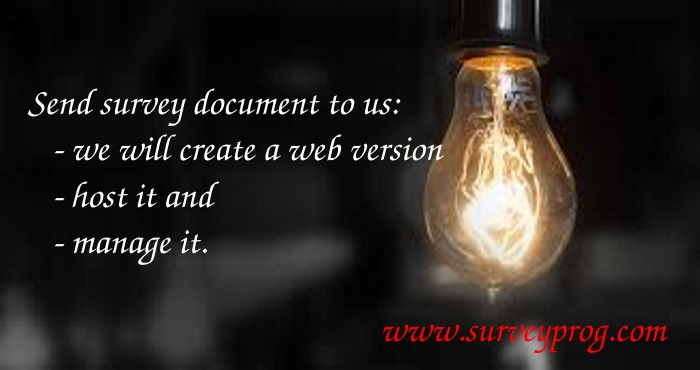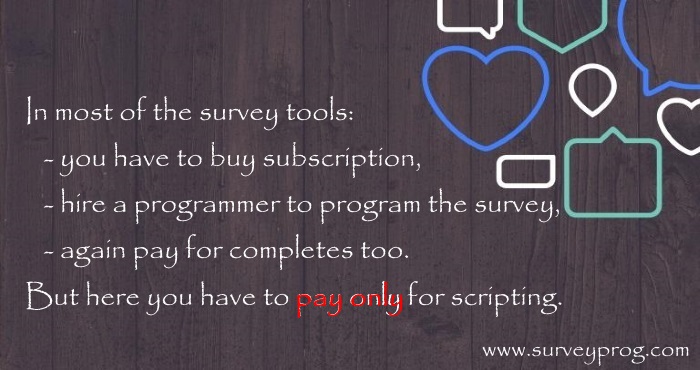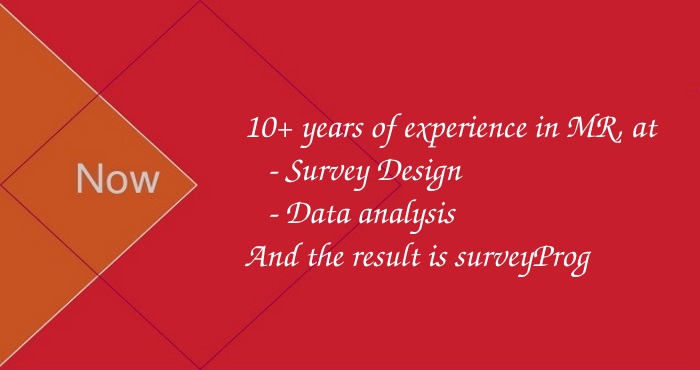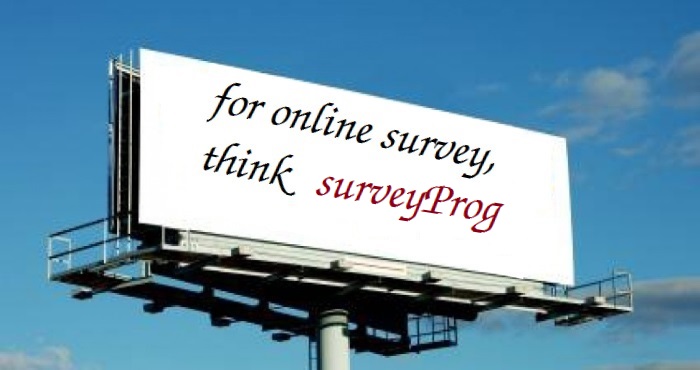SurveyProg Research Solution
Welcome to the blog of market research

Market research methods
We design surveys using our surveyProg tool. April 19, 2018
When conducting market research, you may be trying to study:
- Attitudes - how a respondent thinks or feels about something
- Behaviours - what actions the respondent has taken or plans to take
- Demographics - such as age, income level, and gender
- Firmographics - the characteristics of an organization
Table of Contents
- Surveys
- Focus groups
- Personal interviews
- Task analysis
- Usability testing
Surveys
Surveys involve asking a series of questions to a sample of the target population that is large enough to be statistically valid. Surveys generally offer primarily closed-ended questions, although some open-ended questions may be included. Surveys can be administered by mail, telephone, email, Internet or in person.Best uses
- Develop a profile of your users:
- Identify client segments
- Determine client characteristics
- Validate or prioritize customer needs
- Assess client satisfaction
- Gauge customer awareness:
- General awareness about your business
- Post-advertising campaign awareness
- Track changes in attitudes and opinions
Focus groups
Focus groups are moderated group interviews and brainstorming sessions that provide information on users' needs and behaviours.Best uses
Focus groups can be useful for the following types of discussions:
- Exploratory - Obtain information on general attitudes, understand the circumstances under which customers might require your product or service (triggers), understand their desired outcomes, and so on.
- Feature prioritization - If trade-offs have to be made among various customer needs, focus groups can be helpful in prioritizing them.
- Comparative analysis - Understand where else customers go to get similar information, services or products and what attracts them to those sources.
- Trend explanation - If you notice a trend in the way that customers use your website (for example, they always use the search function rather than navigating through the structured product list), then focus groups can be used to better understand why this is happening.
Personal interviews
Personal interviews are semi-structured discussions with an individual. They include open-ended questions where the interviewer can probe further to understand underlying perceptions and behaviours.Best uses
Personal interviews are a more expensive alternative to focus groups and are generally used in the following situations:
- The topic is too personal or sensitive to be discussed in a group, or confidentiality of the participant is required.
- A person's opinion may easily be influenced by others in the group.
- It is as important to learn as much about what people don't know about a subject, as what they do know. In a group setting, knowledgeable participants may inhibit less knowledgeable ones from participating.
- Logistic problems may make groups impractical. For example, if participants are geographically dispersed, travel time and costs may be prohibitive.
- The interview subjects are executives from competing firms who would be reluctant to open up in a group situation.
- The interview subjects are busy and it is difficult to schedule group sessions, or it is important to visit interview subjects individually at their convenience.
Task analysis
Task analysis seeks to understand the thought process and actions of participants in order to improve the design of a website or tool. The participant is given a specific task to perform, and the interviewer observes and notes where the participant runs into problems and where he or she is successful. It is different from usability testing, as it is not testing the usability of a website.Best uses
Task analysis can be helpful in understanding how people currently use your website (or other websites). Using this approach, the participant is given a specific task to perform. For example, buy a particular product or find the location of a nearby store that sells your product.
Usability testing
Usability tests are structured interviews that focus on the usability of specific features of a website or other user interface.Best uses
Usability testing is best used to evaluate prototypes of planned websites or planned changes to an existing website. It is used to evaluate the interface and to note any problems faced by users, in order to give feedback to developers.

Our service
surveyProg superior in survey design for market research that are flexible, robust, dependable and scalable in supporting our clients ever-changing needs in this dynamic arena of market research.

Our Mission
Send survey document to us. We will create a web version, host it and manage it. We also use an array of languages like ConfirmIt, Dimensions and also data analysis with the support of Quantum, IBM SPSS, Tableau and Power BI. The programmers are ready to fulfil the clients requirements 24/7.

About our company
We pride ourselves in providing innovative services in survey program to support our clients with their complex requirements. surveyProg have devised several survey methodologies and system which are applicable as per our clients requisites. More over our surveys are mobile friendly.
Popular Posts
-
 Survey Design
Survey Design
We design surveys using our surveyProg tool. -
 Questionnaire
Questionnaire
Send survey document to us. We will create a web version, host it and manage it. -
 Survey Tool
Survey Tool
Mobile friendly surveys. No charges for completes.
Tags
Survey Design Questionnaire Survey program Survey scripting Online survey Market research Survey tool survey questions survey maker quantitative research qualitative research survey app
